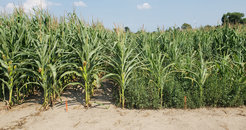Agriculture makes the weed
How intensive agriculture turned a wild plant into a pervasive weed
Agriculture is driving rapid evolutionary change, not just on farms, but also in wild species in the surroundings. New research shows how the rise of modern agriculture has turned a North American native plant, common waterhemp, into a problematic agricultural weed by mutations in hundreds of genes related to drought tolerance, rapid growth, and resistance to herbicides.

Researchers at the University of British Columbia, the University of Toronto, and the Max Planck Institute for Biology Tübingen have compared 187 waterhemp samples from modern farms and neighboring wetlands with more than 100 herbarium samples dating as far back as 1820. Much like the sequencing of ancient human and Neandertal remains has resolved key mysteries about human history, studying the plant’s genetic makeup over the last two centuries allowed the researchers to watch evolution in action across changing environments.
The scientists could document how a weedy variety of waterhemp apparently expanded over time from West to East in North America. On the way, it exchanged parts of its genome with different local populations, making the plants even more adapted to the local agricultural environment. The researchers discovered hundreds of genes across the weed’s genome that aid its success on farms, with mutations in genes related to drought tolerance, rapid growth, and resistance to herbicides appearing frequently. “The genetic variants that help the plant do well in modern agricultural settings have risen to high frequencies remarkably quickly since agricultural intensification in the 1960s,” says first author Julia Kreiner from the University of British Columbia. “These results highlight the exciting potential of studying historical genomes to understand plant adaptation on different timescales,” further comments co-author Stephen Wright from the University of Toronto.
Strong selection pressure
Common waterhemp is native to North America and was not always a problematic plant. Yet in recent years, the weed has become nearly impossible to eradicate from farms thanks to genetic adaptations including herbicide resistance. “Waterhemp has basically evolved to become more of a weed because of how strongly it has been selected to thrive alongside human agricultural activities,” explains co-author Sarah Otto from the University of British Columbia. Notably, five out of seven herbicide-resistant genes found in current samples were absent from historical samples. Waterhemp carrying any of seven herbicide resistance mutations tended to produce nearly 20 percent more surviving offspring per year, on average, since 1960.
“While this study was carried out with North American samples, we have similar problems with herbicide resistance in Europe. Therefore, our study serves as a blueprint for efforts to understand how plants become successful agricultural weeds also in Europe,” states co-author Detlef Weigel from the Max Planck Institute for Biology Tübingen.
The findings of this study could also inform conservation efforts to preserve natural areas within agricultural landscapes. “While such preserves are important, it needs to be acknowledged that the natural populations become genetically different from what they would have looked like in the absence of surrounding agriculture,” explains Detlef Weigel.
